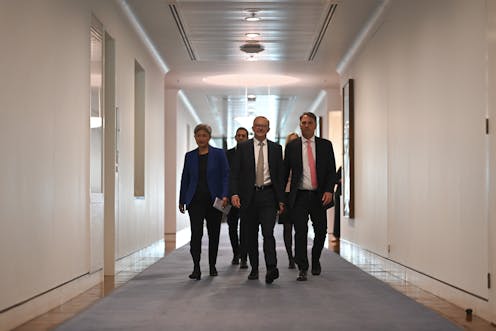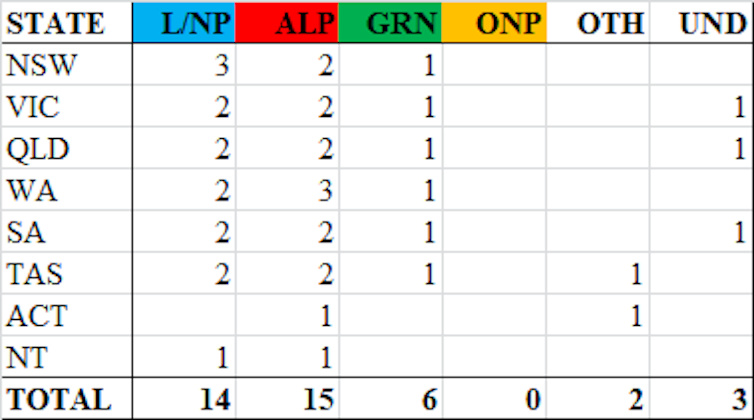Source: The Conversation (Au and NZ) – By Adrian Beaumont, Honorary Associate, School of Mathematics and Statistics, The University of Melbourne

AAP/Lukas Coch
At this election, 40 of the 76 senators were up for election – six from each state and two from each territory. 72% of enrolled voters nationally for the Senate have now been counted, up from 38.5% on election night.
Read more:
Election results update: Labor to form government as both major parties’ primary votes slump
Going into the election, the Coalition held 35 of the 76 Senate seats, Labor 26, the Greens nine, One Nation two, Centre Alliance one and Jacqui Lambie one. The remaining two seats were filled by party defectors: Rex Patrick from Centre Alliance and Sam McMahon, who quit the Northern Territory Country Liberal Party and became a Liberal Democrat.
Read more:
Race for the Senate: could Labor and the Greens gain control?
The seats up for election were Coalition 18, Labor 15, the Greens three, One Nation one, Centre Alliance one and both defectors. Labor, the Greens and other left parties needed to make four combined gains from the Coalition, One Nation, Centre Alliance and defectors to gain control.
As explained in the earlier article, the Senate uses proportional representation with preferences. Voters are instructed to number at least six boxes above the line, though only one is required for a formal vote.
With six senators to be elected in each state, a quota is one-seventh of the vote or 14.3%. With two up in each territory, a quota is one-third or 33.3%.
The state senators elected at this election will have six-year terms starting July 1, unless there is a double dissolution. The territory senators have only three-year terms that are tied to the term of the House of Representatives.
While it is often clear who will win the six seats for a state or two for a territory from analysing primary votes, in some cases we will need to wait until all votes are counted and electronically entered into a computer system that distributes preferences (the button press).
The final day for reception of postal votes is this Friday. Button presses will not occur until at least next week. The count is well advanced in Tasmania and the ACT, and these may be finalised next week. For the other states, it’s likely to take another week.
Both above the line party votes and below the line votes for candidates are initially counted as “unapportioned” for a party. As the count progresses, they are assigned either to “above-the-line” or candidate votes. When the number of unapportioned votes reaches zero, we are near the button press.
National summary
The table below shows the likely senators elected for each state and territory. UND means the seat is currently undecided.

In summary, Labor and the Greens combined needed to gain four seats to control the 39 of 76 senators needed to pass legislation. They are likely to gain seats in Queensland, WA and SA, while in the ACT a climate-friendly independent (David Pocock) is likely to win.
If these are the results, with Labor still a chance of winning three in Victoria and SA, then Labor and the Greens would have 38 of 76 senators combined. Labor would need the Greens and one of Pocock or Jacqui Lambie (now at two senators) to pass legislation opposed by the Coalition.
I believe it is an advantage that the two main parties of the left (Labor and the Greens) are both capable of winning quotas or near quotas in all states. On the right, only the Coalition consistently achieves this.
It would be easier for small right-wing parties to win seats at a double dissolution, when all 12 senators for each state are up, and the quota is nearly halved to 7.7%.
State results
With 74% counted in NSW, the Coalition has 2.59 quotas, Labor 2.14, the Greens 0.79 and One Nation 0.28. The Coalition’s third candidate is too far ahead, and the result will be three Coalition, two Labor, one Green. This will be a Green gain from Labor.
With 72% counted in Victoria, the Coalition has 2.29 quotas, Labor 2.23, the Greens 0.92, UAP 0.27, Legalise Cannabis 0.20 and One Nation 0.20. Two Coalition, two Labor and one Green will win with the last seat a mess that is unlikely to be clear until the button is pressed. The UAP and Coalition are the most likely winners.
With 71% counted in Queensland, the Coalition has 2.48 quotas, Labor 1.75, the Greens 0.85, One Nation 0.51 and Legalise Cannabis 0.36. Two Coalition, two Labor and one Green will win, with the final seat a contest between the third Coalition candidate, Amanda Stoker, and Pauline Hanson. This will be a gain for the Greens from either the Coalition or One Nation.
With 66% counted in WA, Labor has 2.47 quotas the Coalition 2.20, the Greens 0.97, One Nation 0.24 and Legalise Cannabis 0.23. Labor will win two, the Coalition two and the Greens one, with Labor likely to win the final seat, for an outcome of three Labor, two Coalition, one Green. This would be a Labor gain from the Coalition.
With 74% counted in SA, the Coalition has 2.36 quotas, Labor 2.31, the Greens 0.83, One Nation 0.27 and the UAP 0.21. Nick Xenophon was not a factor, winning just 0.19 quotas. The Coalition will win two, Labor two, the Greens one, and the last seat is undecided, with the Coalition ahead.
Xenophon’s former Centre Alliance was defending two seats, so the Greens gain one from CA with the other CA loss a gain for either the Coalition or Labor.
With 81% counted in Tasmania, the Coalition has 2.22 quotas, Labor 1.92, the Greens 1.08, the Jacqui Lambie Network 0.59 and One Nation 0.26. The Coalition will win two, Labor two, the Greens one and JLN one. This will be a gain for JLN from the Coalition. Lambie was not up for re-election, but will be joined in the Senate by Tammy Tyrrell.
With 84% counted in the ACT, Labor has 1.00 quotas, the Coalition 0.75, Pocock 0.63, the Greens 0.29 and independent Kim Rubenstein 0.13. Greens and Rubenstein preferences are expected to strongly favour Pocock, who will gain from the Coalition.
With 46% counted in the NT, Labor has 1.02 quotas, the Coalition 0.92, the Greens 0.38 and the Liberal Democrats 0.26. Labor and the Coalition will each win one seat, with the Coalition gaining from a defector.
Labor needs just one more seat for a House of Representatives majority
With 79% of enrolled voters counted in the House of Representatives, the ABC is calling 75 of the 151 seats for Labor, 57 for the Coalition, four Greens, 12 for all Others and three still undecided.
Read more:
Why Labor is likely to win a House of Representatives majority despite a 33% primary vote
In the last few days, Lyons was retained by Labor after a counting error was resolved in Labor’s favour, while Brisbane was gained by the Greens from the Coalition after they led Labor by 1.0% on the electoral commission’s “three candidate preferred” at the point where one of Labor or the Greens were excluded, handing the seat to the other on preferences.
The three remaining undecided seats are Gilmore, Deakin and Macnamara. Gilmore and Deakin are standard two-party contests with the Coalition narrowly ahead after counting of nearly all Coalition-favouring postals. Labor has a good chance to regain the lead in Gilmore on absent votes that favour Labor; these are election day votes cast outside a voter’s home electorate.
Macnamara is another Labor vs Greens contest that the Coalition won’t win. If it’s Labor vs Greens, Labor wins on Coalition preferences. If it’s Labor vs Coalition, Labor wins on Greens preferences. If Labor finishes third, the Greens beat the Coalition on Labor preferences.
The “three candidate preferred” in Macnamara has the three parties nearly tied with Labor just behind the Coalition and just ahead of the Greens. However, remaining votes are likely to help the Greens.
Labor struggles in these three party contests because right wing minor parties’ preferences go to the Coalition, while preferences of Animal Justice Party voters go to the Greens.
![]()
Adrian Beaumont does not work for, consult, own shares in or receive funding from any company or organisation that would benefit from this article, and has disclosed no relevant affiliations beyond their academic appointment.
– ref. Labor likely to get a friendly Senate and still hoping for House of Representatives majority – https://theconversation.com/labor-likely-to-get-a-friendly-senate-and-still-hoping-for-house-of-representatives-majority-183931








